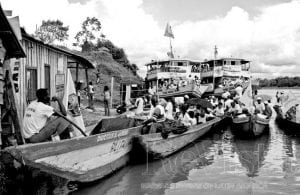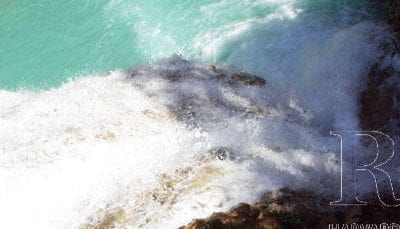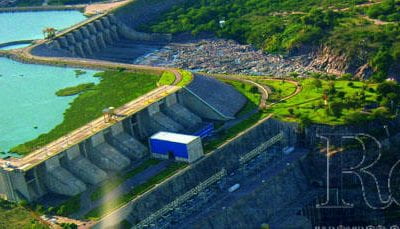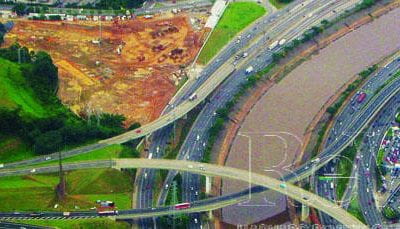Al Son Del Río (English version)
Water Rights in Chocó, Colombia
Wending our way down the Atrato River in Colombia’s Chocó region, we finally reach the town of Puné. It is a fickle June afternoon, one of those humid tropical afternoons when the sun and water alternate in sudden torrential rains. “The river is everything to us,” Berta is telling me as we drift along the “fluvial highway,” which from time immemorial has connected fresh water with the salty sea, moving from the Pacific to the Colombian Caribbean. The water in Chocó is part of its symbolism, its social fabric; it is an essential part of spatial reference and identity of the communities. Baptisms and spells, enchantments and incantations all express the importance of water. Water is not merely a necessary service; it is also a collective good that has a deep cultural dimension.
The stockades to trap fish, plots flooded to grow rice, dikes and basins for the harvest, plains for gold mining, water courses as a way of marking territories, all these make up traditional practices that sustain the agro-forest systems, artisan mining and fishing. “People, depending on their productive activities, go along with the river. People move to the beat of the fish, the wood, the mines (…). The fish, just like a human being, knows when the river is going to dry up or when it is going to rain, so it becomes a game of anticipating the ebb and flow of the river, for opening and closing the stockades,” Eulise tells me as she teaches me about the river.
Ever since we left the port of Quibdó, we have been passing through the collective land of the black communities of the Medio Atrato region. We encounter other boats, carrying—just like ours—all sort of local treasures: dried fish, bananas, cocoa, rice, wood. From the platform, lying in hammocks or playing dominos, crew members greet us with a wave. On both sides of the river, fishermen float in their canoes; women wash clothes on the shore, and children play. They all pause to watch our boat pass by. The green flag on its prow is well known along the river and its tributaries, because it identifies members of the Integral Peasant Association of the Chocó’s Medio Atrato, known by its Spanish acronym as ACIA. “The armed groups know who we are by this flag,” other passengers explain. They are used to slipping alongside the border of the invisible war that hides deep in the jungle.
Since 1997, ACIA has spearheaded a pilot project of collective land titles, one of the most radical experiences in Latin America and perhaps the most important in terms of agrarian reform in Colombia. The 1993 Law 70 granted rights to the black population stemming from its ethnic and cultural roots and set forth certain mechanisms to protect these communities and allow them to maintain their traditions of collective property rights. ACIA, integrated as the Greater Community Council (Consejo Comunitario Mayor-COCOMACIA), be-came the representative of black communities in this region of the country.
The sense of belonging to the river and its environs deeply influenced the processes of political organization in the Atrato. Guided by the flow of the waters, the communitarian councils established ethnic-territorial boundaries, using the principles of planning for hydrographic basins. Since then, natural markings such as rivers, streams and swamps have continued to be used as spatial references for land jurisdiction, in keeping with the local ways of perception and environmental use as well as the kinship logics that the black communities have long followed.
As we move down the river, we observe among the tropical pichindés, banana and fruit trees, clusters of stilt houses in small communities along the shore. Using thick trunks of the guayacán tree, the river inhabitants build these houses to deal with recurring floods. In this way, they can live alongside the ebb and flow of the river, which constantly deposits marsh debris under their houses. However, the inhabitants wonder why the relationship with the “little game of the river’s ebb and flow” has been changing lately: “Now we don’t know when it is going to flood.” These disturbances in the natural rhythms of the water have drastic implications for the health and daily life of the population. Julia tells me that when the Bebaráma River “floods, the mosquitoes take over,” which implies greater risks of malaria and other diseases.
“Sometimes we have to sleep with the water under my bed,” adds Berta; “if the mouths of the Atrato were dredged, it wouldn’t flood so much.” Until the 1980s, floods came in a regular and predictable form, coinciding with the region’s winter. However, the removal of earth from the beds of rivers and streams with heavy machines to mine gold has caused sedimentation; it changed the river’s flow and, indeed, affected its navigatability. In the same fashion, indiscriminate lumbering is causing problems on the banks of tributaries and headwaters: artificial canals built to float the logs cause the natural course of the waters to deviate, while discarded waste produces sedimentation and chokes the river. The mechanism is simple, Carlos tells me: “when the river is made less deep because of continual sedimentation, it loses its flow intensity and ends up flooding the riverbanks.”
The territory of Chocó, knitted together by a tangle of rivers, streams, swamps and brooks, is considered one of the rainiest and most biodiverse regions in the world. Nevertheless, the dwellers alongside the banks of the Atrato suffer a chronic shortage of water fit for human consumption. The superficial water sources, available in abundance, are exposed to all sorts of contamination and sewage. Everyone seems to agree “the only clean water is the kind that comes in a downpour.” As we make our way along beaches and tributaries, Julia, Carmen and Berta explain the difficulties they face when rain is scarce. During the dry season, daily work multiplies—especially for women—who must set out in boats looking for clean water or walk carrying the water in crocks on the long trip home.
As the meeting point between the Atlantic and the Pacific, Chocó has pompously been called “the 21st century window on the sea” for Colombia. Moreover, it is the center of several megaprojects: transnational highways, an interoceanic canal and electrical connections between the Americas. Paradoxically, the region itself is immersed in the most profound lack of services of potable water and basic sanitation. Aqueduct construction and sewage disposal for Chocó are some of the most deficient in the entire continent. Likewise, the mortality rate due to diseases associated with water stands at least at 10 percent yearly: typhoid fever and paratyphoid, malaria, cholera and diarrhea.
Black men and women identify several factors pointing to the changes experienced in regards to water. They talk about the marshes that are drying up “turning into scrubland.” They tell how sardines and a fish they call “wide-mouth” are disappearing from their diets. They fear the river “will rise up with fury and sweep away the houses,” and they evoke the “ambushed” rivers that disappeared with the path of the dredges. They lament that streams have become contaminated and that fishing is no longer possible. They miss wading in the brooks on their way to plant the fields.
The collective project of the black population of the Atrato is threatened by conflicting interests seeking to occupy and exploit the region. Gold and other mining resources, as well as lumber and biodiversity, attract independent settlers—colonos—and small businesses with or without formal concessions, as well as huge multinational companies backed by the government. The water, like a mirror, reflects these territorial contradictions.
María Albina lets off steam: “The dredges took out the gold, damaged the river and left it in ruins…” The chemical contamination by the fuel and oil from the machines and by the mercury used to amalgamate the metal affect fishing, worsening the dwellers’ diet. The waters that originate in the mining zones come downstream filthy and filled with sediment. They cannot be used even to wash clothes or to prepare food, “not even to clean the house,” she says.
On the other side, the swamps in Tumaradó, Perancho and la Honda, once important water regulators, are affected by the indiscriminate timber exploitation at the riverheads. As Gonzalo asserts, “Dead forests, dead rivers.” The river has its rights and belongings: “The forests are the patrimony of the river.”
War has also marked these communities. Pacho recalls that in his little village, “The armed groups took control of everything, even the times we could go fishing. One could only go out to the river between 6 a.m. and 6 p.m. and this was very difficult…sometimes the armed actors set up camp at the river mouth, and people didn’t want to go there to cast their nets any longer…this changed people’s habits.”
The restriction on mobility and lack of access to food necessarily affected collective work and the cultural structures which had defined production and self-sufficiency. Moreover, and by far the worse, the river itself had become the stage for death. “In ‘97, ‘98, ‘99, dead bodies would go floating down the river. So when we found a body in the river, we would try to give it back its personhood, to treat it as a human being: vamos a hacer gente. But back then, in that period, we couldn’t even think about that; people were even afraid to find the bodies because if you fished out a body, you just might get killed for that. Keeping quiet was very hard….”
It took us four hours to get to Puné. When we disembark, we see that the river is getting dry and that a large slice of beach is between us and the little village. The next morning the river continues to be “deviated.” I stumble on seven naked boys and a little girl who are pretending to be fishermen on the beach; they dig stockades; they play at catching the river fishguagucos; they toss nets into the air. Meanwhile two-year-old Davinson tries out his luck with swimming. His mother, washing clothes, warns him not to leave the riverbank. He replies with a playful splash.
Thus, as they pass the time playing, the children wait for the men who had gone to the marsh to fish. They challenge each other as to which dad would bring in the biggest fish. “My dad is going to bring in a huge toothy fish” shouts the little girl. “But my dad is going to come with lots of bocachico,” replies the other kid—”and a net full of kicharos.” And a third child insists,“My uncle is going to get a big catfish, a super-duper huge catfish—big enough for all of us to eat.”
That’s how they see and dream the river, and when they distinguish the boats from a distance, they all run to meet them.
Al Son Del Río (Spanish version)
El derecho al agua en Chocó, Colombia
By Diana Lucía Duque Marín
“El rio es un mensajero, baja contando lo que sucede aguas arriba. Hay que interpretar lo que baja por el rio…leer si hay inundaciones, si vienen los muertos…”
Roberto
Bajamos por el río Atrato hasta llegar a Puné en una voluble tarde de junio, esas familiares tardes chocoanas de bosque húmedo tropical, donde el sol y el agua se entremezclan en intempestivos aguaceros. “El río es todo para nosotros”, me va contando Berta mientras nos deslizamos por “la carretera fluvial” que desde tiempos inmemorables ha comunicado el agua dulce con el mar salado, el caribe colombiano. El agua en el Chocó forma parte de la simbología, del tejido social, de los referentes espaciales e identitarios de las comunidades. Bautizos y hechizos, encantos y conjuros, expresan la importancia del agua no solo como suministro de un servicio, sino también como un bien colectivo que goza de una amplia dimensión cultural.
Las trincheras para atrapar el pescado, los inundados para el arroz, los diques y basines para la cosecha, los llanos para el oro, el caño para delimitar el territorio, forman parte del conjunto de prácticas productivas tradicionales que dan sustento a los sistemas agroforestales, de minería artesanal, de pesca. “La gente, de acuerdo con la actividad que desarrolla, va caminando con el río. La gente va al son del pescado, de la madera, de la mina (…). El pescado, como el ser humano, sabe que va a secar el río o que va a llover, entonces eso se vuelve un jueguito entre seca y creciente, entre tapar y destapar las trincheras”, me recuerda Eulise en sus enseñanzas sobre el río.
Desde que dejamos el puerto de Quibdó estamos atravesando el territorio colectivo de las comunidades negras del Medio Atrato. Encontramos otras embarcaciones, cargadas como la nuestra de todos los tesoros atrateños: pescado seco, plátano, cacao, arroz, rastras de madera. Desde la plataforma, acostados en hamacas o jugando dominó, los tripulantes levantan la mano en señal de saludo. De un lado y otro del río, pescadores en sus canoas, mujeres que lavan ropa en las orillas y niños jugando, paran por un momento al paso de nuestra champa. La bandera verde que ondea a proa es bien reconocida en el río y sus afluentes, porque identifica a los miembros de la Asociación Campesina Integral del Medio Atrato Chocoano, “La ACIA”. “Así los grupos armados saben que somos nosotros”, me explican los pasajeros, acostumbrados a moverse en la frontera de la guerra invisible que se esconde en la manigua.
Desde el año 1999 la ACIA ha liderado el proyecto piloto de titulación colectiva de tierras, una de las experiencias más radicales de toda América Latina y quizá la más importante en términos de reforma agraria en Colombia. La ley 70 de 1993 reconoció amplios derechos a la población negra a raíz de su identidad étnica y cultural, y planteó mecanismos de protección para que se mantenga la propiedad colectiva del territorio según las costumbres tradicionales. La ACIA, conformada como Consejo Comunitario Mayor – COCOMACIA, pasó a ser el ente representativo de las comunidades negras en esta región del país.
La pertenencia al río y la identificación con los espacios acuáticos influenció profundamente los procesos de organización política en el Atrato. Siguiendo los cursos del agua, los consejos comunitarios establecieron las delimitaciones étnico-territoriales a partir de los principios de planificación por cuencas hidrográficas. Desde entonces, los contrastes naturales como ríos, quebradas y ciénagas se han constituido en referentes espaciales de jurisdicción, siguiendo los modelos locales de percepción, uso y manejo del entorno y atendiendo las lógicas de parentela que ancestralmente han manejado las comunidades negras.
Al bajar por el río vamos divisando, entre pichindés, plátanos y frutales, unos palafitos, dispersos en pequeños caseríos. Estas casas elevadas, sostenidas en robustos troncos de guayacán, son construidas por los habitantes ribereños como una medida adaptativa frente a las inundaciones recurrentes. De esta manera conviven con las crecientes y menguantes del río, que va dejando a su paso el pantano acumulado debajo de las casas. Sin embargo, me dicen extrañados, la relación con el “jueguito del sube y baja del río” ha cambiado en los últimos tiempos: “ahora ya no se sabe cuando va a inundar”. Estas perturbaciones en los ritmos naturales del agua tienen implicaciones drásticas en la salud y la vida cotidiana de la gente. Me dice Julia, del río Bebaráma: “donde inunda mucho abunda el zancudo”, lo que implica para la gente un mayor riesgo de exposición a la malaria y a otras enfermedades.
“A veces toca dormir con el agua debajo de la cama, -añade Berta- si las bocas del Atrato estuvieran dragadas esto aquí no inundaría tanto”. El régimen de inundaciones hasta los años ochenta se presentaba de forma regular, coincidiendo con los períodos invernales de la región. Sin embargo, la remoción de tierra en el lecho de ríos y quebradas con maquinaria pesada para la explotación de oro ha ocasionado procesos de sedimentación que alteran no solo los cauces de los cursos fluviales, sino también las condiciones de su navegabilidad. Así mismo, la explotación maderera indiscriminada está generando problemas en las márgenes de los afluentes y cabeceras: los canales artificiales que se construyen para bajar los troncos desvían el curso natural de las aguas, mientras los desperdicios arrojados producen sedimentación de los lechos y el taponamiento de los ríos. El mecanismo es sencillo, me cuenta Carlos, “cuando el río se hace menos profundo, por sedimentaciones continuadas, pierde caudal y el agua busca desbordarse por las riberas”.
El territorio chocoano, tejido por un entramado de ríos, quebradas, ciénagas y caños, es considerada una de las regiones más lluviosas y biodiversas del mundo. No obstante, a orillas del Atrato la gente vive en medio de una crónica escasez de agua apta para consumo humano. Las fuentes hídricas superficiales, disponibles en abundancia, están expuestas a diversas formas de contaminación y vertimientos. Todo el mundo parece estar de acuerdo que “el agua limpia es la del aguacero”. En los recorridos por afluentes y playas Julia, Carmen y Berta me hacen entender las dificultades que viven cuando la lluvia se hace escasa. En los períodos secos del año se multiplica el trabajo cotidiano, sobre todo para las mujeres: recorridos en champa buscando caños limpios, acarreo de agua en vasijas y largas caminadas en busca de fuentes confiables.
El Chocó, por ser el punto de encuentro entre los dos mares, el Atlántico y el Pacífico, ha sido pomposamente denominado “la ventana al mar del siglo XXI” para Colombia. Además es el centro de varios megaproyectos relacionados con carreteras trasnacionales, canales interoceánicos e interconexiones eléctricas entre las Américas. Resulta entonces paradójico que la región esté sumida en la más profunda carencia de servicios de agua potable y saneamiento básico. La cobertura de acueducto y alcantarillado para el departamento del Chocó sigue siendo una de las más deficitarias de todo el continente. Del mismo modo, se registra una mortalidad atribuible a enfermedades asociadas con el agua de por lo menos el 10% anual: fiebre tifoidea y paratifoidea, malaria mixta, cólera, paludismo y enfermedades diarreicas.
Mujeres y hombres negros, identifican numerosos eventos que dan cuenta de los cambios sufridos en sus entornos acuáticos. Hacen referencia a humedales que se van secando y “quedan convertidos en chuscal, tierra y monte“, mencionan como han desapareciendo de su dieta la “sardina y la boquiancha”, temen al río que “se arrecha feo y se lleva las casas”, evocan los ríos “emboscados” que desaparecieron al paso de las retroexcavadoras, lamentan que el agua de las quebradas se haya vuelto “contaminosa y ya no se pueda pescar”, extrañan sus costumbres de meterse por los caños para ir al monte a sembrar.
El proyecto colectivo de la población negra en el Atrato está amenazado por intereses enfrentados de ocupación y explotación del territorio. El oro y los recursos mineros, así como la madera y la biodiversidad, atraen colonos independientes, pequeñas empresas con o sin concesiones, grandes multinacionales respaldadas por el gobierno. El agua, como un espejo, refleja estas contradicciones territoriales.
María Albina se desahoga: “Las dragas nos sacaron el oro, dañaron el río y dejaron la ruina…” La contaminación química con el combustible y aceite de las maquinas y con el mercurio utilizado para amalgamar el metal afecta los peces, empobreciendo la dieta alimentaria de los pobladores ribereños. Así mismo, las aguas provenientes de las zonas mineras bajan turbias y cargadas de sedimentos, no se puede utilizar ni para lavar ropa, ni para preparar alimentos, “ni siquiera para lavar la casa”.
De otro lado las ciénagas de Tumaradó, Perancho y la Honda, en su papel de reguladores hídricos, son afectadas por la indiscriminada explotación maderera en las cabeceras de los ríos. Como afirma Gonzalo: “Muertos los bosques, mueren los ríos”. El río tiene derechos y también tiene pertenencias: “los bosques son patrimonio del río.”
Entre muchas de las afectaciones percibidas por la gente a su espacio vital se evoca con dolor la marca de la guerra. Pacho recuerda que en su caserío “Los grupos armados hacían control total de todo, hasta de los horarios de pesca. Sólo se podía salir al río entre las 6 am y las 6 pm y eso era muy difícil… A veces los actores armados hacían sus campamentos en las entradas de los ríos, la gente no quería pasar por ahí para ir a tirar sus trasmallos…eso cambió los hábitos de la gente.”
Las restricciones en la movilidad, el confinamiento y el bloqueo de alimentos afectaron sin remedio el trabajo colectivo y las estructuras culturales que mantienen las formas propias de producción y auto-sostenimiento. Pero además, y lo peor, el río también ha sido escenario de muerte. “En la época del ´97, ´98, ´99, bajaban difuntos por el río. Tradicionalmente la gente veía pasar un difunto por el río y cualquiera lo cogía, lo tapaba, lo guardaba y hacía gente. Entonces decíamos: vamos a hacer gente. Entonces al encontrar una persona en el río muerta uno iba a hacer gente. Pero en ese tiempo no se podía hacer gente y daba miedo encontrarse un difunto porque si uno lo cogía de pronto lo mataban. Quedarse callado era muy duro…Y lo otro es que el difunto lo podía asustar.”
Nos tardamos cuatro horas hasta llegar a Puné. Al desembarcar nos damos cuenta que el río está en seco y una gran playa nos separa del caserío. A la mañana siguiente el río sigue “corrido”. Me encuentro con siete niños y una niña desnudos, que juegan en la playa a ser pescadores: hacen trincheras, se ensayan con “guagucos”, lanzan redes al aire. Entre tanto Davinson, a quienes todos llaman “Chorro de Humo”, con sus escasos dos años prueba suerte de nadador. Su madre, lavando ropa, le advierte no separarse de la orilla, él le responde con chapuceos en gesto juguetón.
Así, entre juego y juego, esperan a los hombres que se fueron a la ciénaga a pescar. Mientras tanto se retan unos a otros acerca de quien traerá la mejor liga. “¡Mi papa va a traer un dentón gigante!” grita la niña. “Pero mi papa va a llegar con muchos bocachicos -replica el otro- y también Kicharos, ¡un trasmayado lleno!” Y un tercero arriesga a decir: “Mi tío va a sacar un bagre grande, grandisisisimo, y todos comemos de ahí”.
…Así lo ven, así lo sueñan, y cuando divisan las barcas corren a su encuentro.
Diana Duque es consultante e investigadora enfocando en el desarrollo rural y el impacto social del agua. Ha participado en proyectos politicos y sociales en la ONU, en el Instituto von Humboldt, y con gobiernos locales y instituciones de la sociedad civil en Colombia.
Related Articles
Water: The Last Word
A man was shot and killed in a dispute in June 2010 over a water connection in San Juan Cancuc, Chiapas, Mexico. A Zapatista settlement coexists, if uneasily, on the edge of the municipality. Residents of the nearby community of El Pozo had threatened to shut off Zapatistas water connection. A confrontation ensued, shots followed, with one fatality and nine wounded. …
Water, The Energy Sector and Climate Change in Brazil
As a Brazilian, I am very proud of the rich natural resources of my country, in particular water resources. As an engineer who had worked in the Brazilian energy sector for the last fourteen years, I am very proud of the infrastructure built over the last seventy years that has allowed the use of water resources responsibly and intelligently. But as a hydrologist and doctoral student in water resources,…
Water-Friendly Cities?
The world just turned urban. For the first time in human history, urban citizens make up more than half the world’s population, the 2006/2007 UN-Habitat State of the World’s Cities Report tells us. In the last century, Europe and the Americas experienced intense urban growth. Today this is the reality for Asia and Africa….





